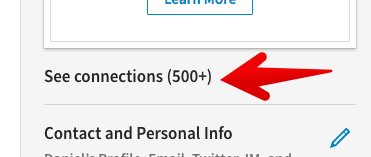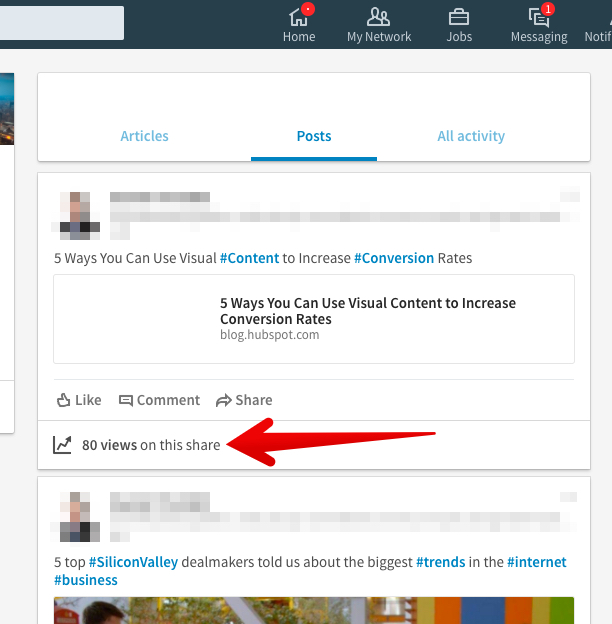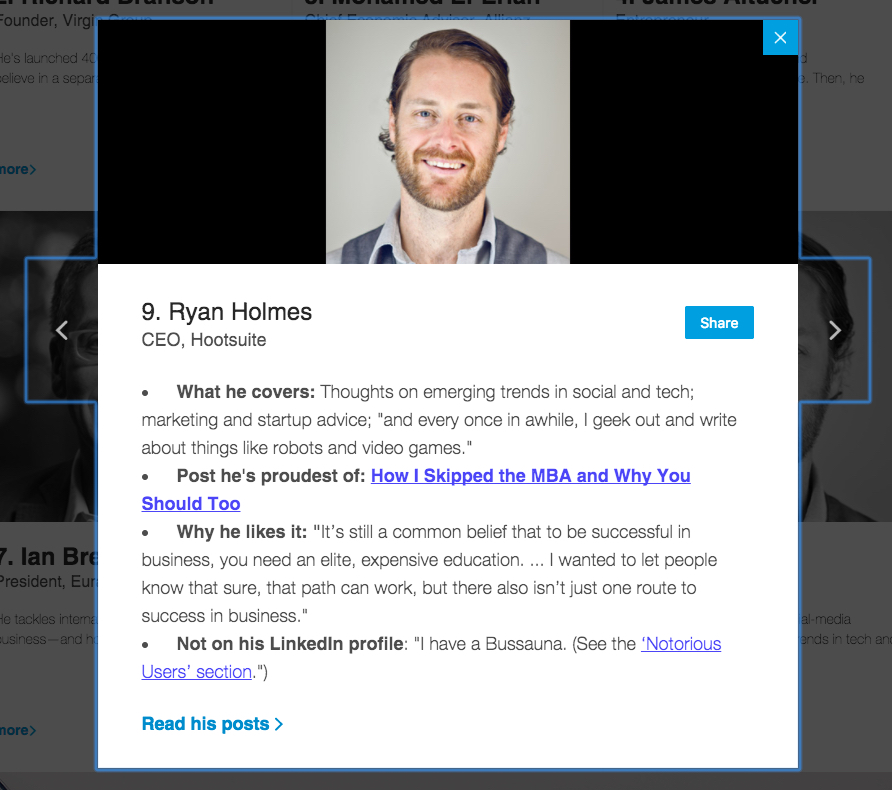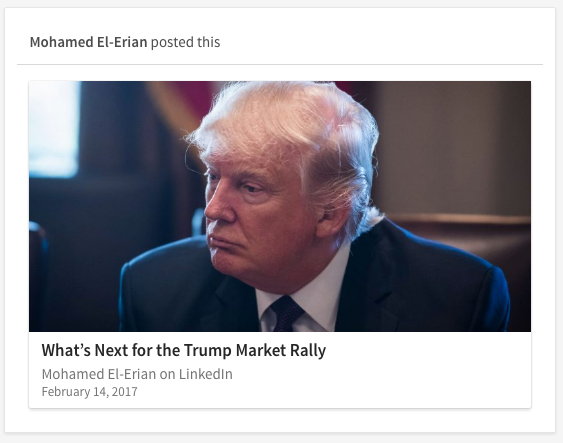One month ago, I was helping my friend with his social media marketing. (He’s a digital agency owner.)
“What social media channel is the most effective for you,” I asked him. “Which one brings in the most leads?”
“Hands down, it’s LinkedIn,” he told me.
“Okay, let’s take a look at what you’re doing there,” I said.
We started checking out his LinkedIn profile and activity. He showed me some of the things he had done that brought in a lot of leads.
What I discovered really surprised me.
For a long time, I’ve known that groups are one of the most powerful ways to generate leads on LinkedIn.
But my friend wasn’t doing a whole lot on groups.
Instead, he was driving leads through something else entirely — articles and posts.
“Posts” on LinkedIn are basic status updates — posting a link, for example. Articles are longer posts that you write in the LinkedIn publishing system.
I spent some time carefully combing through each of my friends shares and posts over the past several weeks.
Sure enough, he was getting a ton of engagement — views, shares, and comments.
As I kept scrolling and clicking through his profile, checking out stats, and looking at details, things started clicking into place. I began to see a pattern.
Quickly, I jotted down some ideas and sketched out a strategy.
When my friend put the strategy into place, his engagement shot through the roof. I’m going to explain this strategy in detail below.
But I wasn’t content to simply see one example of my strategy in play. I started examining the strategy of some of the most influential LinkedIn members (as ranked by LinkedIn).
The strategy I had developed was matching the best practices that these influencers were using.
I asked several of my friends to give the process a try as well. Again, success!
I don’t share any of this to toot my own horn. I tell you this, because there is a proven way to expand your LinkedIn influence through high-engaging techniques.
If you follow the process, you can increase your engagement levels on LinkedIn.
If your success rate is anything like my friend, you can get as high as 78% of your network to engage with a single post!
Learn how I generated 195,013 visitors a month by leveraging social media sites like LinkedIn.
LinkedIn is all about influence (not number of followers)
Before explaining the step-by-step process, I need to share with you the philosophy behind it.
Stick with me, because this is important.
It’s all about influence.
At first, my statement sounds obvious.
But what’s the number one thing that people tend to chase on LinkedIn?
It’s numbers.
But that’s a misguided approach! The real value on LinkedIn is not the number of people in the network, but the influence that you possess within your network.
It’s easy to look at a big network size and think, “Wow. That person is important!”
But who knows? LinkedIn only shows a max of 500 people in a network. 500 isn’t all that huge, really.
Besides, your first-level connections (the 500 number) doesn’t show how big your network really is.
For example, you might have a first-level connection to, say, Bill Gates. On LinkedIn, Bill Gates has a huge following — 6,901,769 when I checked this morning.
Hundreds of thousands of people view, like, and comment on his posts.
If you have a first-level, personal connection to Bill Gates on LinkedIn, then by virtue of your network proximity to Bill, you’ll have a stronger network.
Having a bigger LinkedIn network doesn’t make you more influential. Instead, having voice and authority makes you more influential.
That’s what the rest of this article explains — how to grow your voice and authority, not your number of followers.
Follower counts are like pageviews. It’s kind of a vanity metric.
How to find out the real size of your network
Several years ago, LinkedIn would show you exactly how many first-degree connections, second-degree connections, and third-degree connections you had.
It would also display your total network size.
This is what the display used to look like.
That readout is long gone.
You can see, at a glance, how many followers you have.
But these are just followers. That’s not the actual size of your network.
However, it’s relatively easy to get estimates on your network size.
First, go to your profile page.
Do this by clicking on “Me” in the upper right corner.
Then click “view profile.”
From your network page, click “See Connections” on the right sidebar.
You’ll see a page that shows all your first-level connections.
That number is the real size of your immediate network.
Now, let’s dig down to see the size of your network beyond your first-degree connections.
Click the “Search Connections” search field.
Type the asterisk symbol — * (shift + 8).
Press enter on your keyboard.
You’ll see only your first-level connections again. Now, however, we’re going to filter those search results.
On the right sidebar, you’ll see a section that says “Filter People by.” By default, only the 1st degree connections are displayed.
Click the “2nd” button.
Now, LinkedIn displays the size of your network including 2nd-degree connections. This number includes the first-level connections of your first-level connections.
Click 3rd to see an even bigger number.
To get an even more detailed look at your LinkedIn network, you can try the tool from SociLab.
SociLab uses advanced network visualization analysis to produce some detailed insights into your network.
The display might look something like this. (It can get a little bit confusing.)
The tool provides a readout of your network metrics, too.
The main limitation to this information is that it only analyzes 499 of your connections. Since I have over 110,000 first-level connections, these numbers are unreliable for me.
It’s helpful to check out your network size from time to time. Doing so helps you understand the number of people you’ll be able to reach with your status updates and personal interactions.
The argument that I’m advancing in this article is simple: To truly be an influential LinkedIn player you’ll need to expand your influence, not just your network size.
Does expanding your network size help? Of course, it does!
The more people you can reach, the greater your potential influence.
But what if you’re in a really narrow niche, like lion taming?
I don’t have any first-level lion tamers in my network.
But apparently, there are a few of these brave souls on LinkedIn.
If you’re in the lion taming industry, you might not need a lot of connections. A few circus directors, fellow lion tamers, and maybe a zookeeper or two, right?
So when you post a status update, it’s not about the number of people who read it.
It’s the quality of people who read it.
And, if you’ve curated your network carefully, it’s the percentage of people within your network who read it, too.
This is a far more accurate barometer of influence.
In the long run, it’s more valuable, too.
Social media has trained us, for better or worse, to seek out bigger networks, more friends, and a higher number of likes.
But in the real world of business and influence, these are cheap stats.
The process I’m going to show you is more meaningful. It will get you more results, more leads, a better network, and a growing influence.
To have influence, you need to build the right foundation
Since this article is about increasing your post engagement, I’m going to spend very little time on this section.
The point I want to make is this: In order for your shares to get views, then you need to have a strong LinkedIn presence.
If you don’t have one, start building it.
Here’s a quick-start guide to doing so:
- Use your best professional headshot for your profile picture.
- Develop a strong, polished profile. This is your online reputation. Make it honest, and make it look good.
- Add people to your network. Don’t just wildly add anyone you see. Add people whom you know or who know you.
- Consistently share links, articles, and content that is relevant to your target audience.
Building a strong LinkedIn network takes time and effort, but it’s super valuable.
If you give it at least ten minutes a day, you can build a very powerful and influential network in just four weeks.
To go beyond the basics of those four bullet points, here are some other helpful articles I’ve written about LinkedIn.
Reading and following this information will help you build the right foundation on LinkedIn.
- How to Structure a Perfect LinkedIn Profile
- 5 Tried and Tested Lessons on Growing a LinkedIn Group
- How to Combine LinkedIn and Content Marketing to Generate Incredible Leads
- How to Increase Your LinkedIn Engagement by 386%
- 5 Strategies for Building a Bigger Network on LinkedIn
- Generate Leads from LinkedIn Through 6 Simple Steps
To gain true success from the advice that follows, you should build and sustain a strong and active network.
Measure your current influence
Next, let’s set a benchmark for your influence.
How can you find out the number of people who are viewing and interacting with your shares?
Go to your profile by clicking “Me” in the top menu.
Then, click “View Profile.”
If you’ve been sharing updates in the past, you’ll see some recent numbers about your share and profile views.
Click “Views of your share” to get more details. You’ll see a display of all your recent shares along with view counts.
Check out your recent shares and see what kinds of percentages you currently have.
For each of the share metrics, you can take a closer look by clicking on the line that says “## views on this share.”
This information is helpful because it helps you understand how your network is responding to your shares.
For example, here are the engagement stats for a recent article I shared:
I’m not sure why I had a lot of O’Reilly employees looking at the article. Perhaps someone in the organization shared it, and it got distributed among the department.
Also, I noticed that a lot of marketing specialists were looking at this article. This is another helpful insight into my target audience.
One other interesting feature of this particular article was that it was shared primarily through my second-degree network, not my first degree connections.
Every post is different. Thus, every post will have a different set of metrics.
Here is the information available in each post summary:
- The companies or affiliations that your viewers are part of.
- The titles that your viewers have.
- The location where your viewers are.
- The network relationship of your viewers (first, second, etc.)
- How your article was found.
Everything you share will automatically start collecting engagement information. Just click the chart icon to check it out.
You should keep an eye on these statistics and numbers.
Why? Because they’ll change based on what you’re sharing and when you’re sharing.
For example, if you post about lion taming, you’ll probably get more views, clicks, shares, and likes from lion tamers, but maybe not as many from digital marketers.
As you view these numbers, you’ll learn what your network likes and wants. And you’ll understand how best to give it to them.
What should you post?
The biggest issue in this discussion is deciding what to post.
The single issue to remember here is quality matters.
Think of your LinkedIn network as a mastermind of trusted friends. The group consists of mentors, mentees, influencers, professionals, people of high net worth and power.
Pretend you’re sitting around a table with them.
You respect them. You value their time.
And you have a turn to speak.
What are you going to say?
You want to say something that matters, right?
You want to add depth and quality to their life.
You want them to see you as a person of influence and intelligence — someone who deserves respect.
That’s what’s going on with LinkedIn. You have this group of professionals. You want to share something of value and meaning, not some random crap that popped into your head.
So, the bottom line is to give quality, but we need to get more detailed than that.
As I studied major influencers and other leaders on LinkedIn, here are the tactics that generated the highest level of engagement.
Post about issues that are relevant to your network.
Who gets to decide what you post?
Your network. The people you want to influence.
Sure, you have a role in deciding. But the most important factor in making this decision is the people in your network.
You should ask two questions when deciding what to post:
- Who am I trying to reach?
- What are they interested in?
It’s going to vary from niche to niche. But whatever you do, be relevant.
As an example, I’ll show you Ryan Holmes, a LinkedIn-selected Influencer.
Here’s LinkedIn’s snapshot of him.
Notice that section, “What he covers.”
Thoughts on emerging trends in social and tech; marketing and startup advice; “and every once in awhile, I geek out and write about things like robots and video games.”
I think it’s safe to assume that he’s trying to reach people in social and tech. Maybe a few gamers and robot enthusiasts, too. Marketers, maybe. Tech startups. Definitely.
So what does Ryan share?
Aha! Techy geeky stuff about social media!
Sure enough, all of Ryan’s posts and shares are directly relevant to the people whom he’s trying to reach.
He’s a social media guy, so he’s posting about social media.
He writes about social media trends.
Whatever your niche, it’s really important that you post relevant information.
It’s tempting to spew forth our political opinions or give voice to our pet peeves.
But that’s not quality stuff!
If you were sitting around the table with a prestigious group of professionals, you probably wouldn’t complain about the rude behavior of the waitress or your dark feelings about the current state of politics.
Instead, you would say something that’s relevant and adds value.
Post about real problems that people are facing.
Let’s get even more specific.
In addition to being relevant, you should post about the issues that are most important to your audience.
To do this effectively, you’ll really need to understand who it is you’re trying to reach.
A great example of this is Sramana Mitra. She’s the founder of One Million by One Million.
The goal of her organization is to help one million entrepreneurs achieve $1 million in annual revenue.
There’s another angle, though. She focuses on bootstrapping tech startups.
She knows her audience.
The content she shares on LinkedIn directly addresses the problems her audience is facing! Check this out.
She posts about billion-dollar unicorns, about bootstrapping a unicorn, about a hot entrepreneurial market (Brazil), about women in business, and about mentorship.
This is exactly what her audience is interested in. It’s no surprise that she earns high levels of engagement on here posts.
Let’s go back to Ryan Holmes for a minute.
Remember, he’s trying to influence social media marketers. So what does he do? He posts an article about the problems that are killing social media and how to fix them.
Evidently, an article like this resonated with his audience, because it had high engagement stats.
Use the first-person when you post.
This point is easy to overlook, but very important regardless.
If you’ve read any of my articles, you know that I always write from the first person. I share stories, experiences, and use the words “me,” “my,” and “I.”
Why do I use the first person?
Because I’m a real person. I’m talking to real people. I try to write the same way I talk. It feels more natural that way.
Why should it be any different when I’m posting a status or update?
In my analysis of the LinkedIn influencers, I found that their posts with first-person references had the highest engagement rates.
Richard Branson does this with most of his updates.
When I see Branson’s updates, I feel a personal connection.
This makes the post more compelling and invites my engagement.
Use an image of a face.
Human psychology teaches us that we are instinctively drawn to look at human faces.
One LinkedIn influencer, Mohamed El-Erian, often uses images of a face when he posts on LinkedIn.
El-Erian does this intentionally. It’s not like LinkedIn is just randomly pulling in an image to stick to the status. Instead, El-Erian loads his own image, because he creates the article himself.
Here are his five most recent posts.
It’s not like he’s posting pictures of sexy models or movie stars. His topics — policy, economy, markets — aren’t super exciting.
What gets our attention is the images of people.
When you write a LinkedIn post, choose the image of a person’s face as your header image.
All else being equal, posts with a picture of a face will perform better than posts with no picture of a face.
Post your own articles.
My final point is the most time-consuming, but it’s nonetheless important for becoming an influencer.
Whenever possible, write your own articles.
Time and again, as I studied hundreds of posts and thousands of LinkedIn activity metrics, I noticed that when the influencer posted content that he or she wrote, the engagement was higher.
I first noticed this on my own page. When I posted articles written by other people, the engagement was so-so.
But when I posted articles that I wrote, engagement went way up.
It got even better. When I posted articles within the LinkedIn publishing system, engagement went higher still!
The point of the highest engagement happened when I posted within LinkedIn itself.
To write an article, all you need to do is click “Write an Article” from the main LinkedIn page.
You’ll be taken to a new page where you can begin writing.
Being a content producer is the highest level of influence that you can have within LinkedIn.
It’s what all the major influencers do. It’s the best way to publish original content that positions you as a leader.
Those are the ingredients of a super-successful post or share.
Conclusion
When you mix all these ingredients together, you will start to see higher levels of engagement immediately.
Will your post engagement level automatically rise to 78% of your total network?
It’s possible, but unlikely. Here’s why.
Remember what I wrote about having a solid foundation to your LinkedIn presence? The better your presence to begin with, the higher levels of engagement you’ll see.
Few people rise from social media obscurity to stardom overnight. (It happened to Ken Bone. He got 200,000 Twitter followers literally overnight.)

(FILES) In this file photo dated October 9, 2016, Ken Bone (2nd L) listens to US Democratic nominee Hillary Clinton and Republican nominee Donald Trump during the second presidential debate at Washington University in St. Louis, Missouri.
As the mud flew at Donald Trump and Hillary Clinton’s second presidential debate Sunday, the American everyman became an instant celebrity by calmly asking a question about energy policy. Bone — even his sturdy name has been a source of amusement on social media — had been picked to represent undecided voters at the town hall-style debate in St Louis, Missouri. His heft, poise and polite manner offered a brief but refreshing respite from the 90-minute slugfest between the Republican and Democratic candidates.
/ AFP / POOL / Tasos Katopodis / TO GO WITH AFP STORY “Ken Bone, everyman hero in a tawdry US campaign” (Photo credit should read TASOS KATOPODIS/AFP/Getty Images)
But if you’re not Ken Bone, amassing that level of recognition, not to mention influence — will take a lot longer.
And that’s the final secret ingredient to a super-engaging LinkedIn post.
Consistency.
If you keep it up, you’ll gain incremental levels of improvement. Each time you post with intention, strategy, and value, you’ll build respect, gain influence, and improve your engagement.
What’s your experience with LinkedIn posts and shares? What methods have you found to be most successful at increasing your engagement?




















































Comments (116)